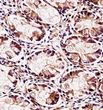Dysadherin (FXYD5) (Center) Rabbit Polyclonal Antibody
Other products for "FXYD5"
Specifications
| Product Data | |
| Applications | IHC, WB |
| Recommended Dilution | Peptide ELISA: 1/1000. Western Blot: 1/100-1/500. Immunohistochemistry on Paraffin Sections: 1/10-1/50. |
| Reactivities | Human |
| Host | Rabbit |
| Isotype | Ig |
| Clonality | Polyclonal |
| Immunogen | KLH conjugated synthetic peptide between 71-100 amino acids from the Central region of Human Dysadherin / FXYD5 |
| Specificity | This antibody recognizes Human Dysadherin / FXYD5 (Center). |
| Formulation | PBS containing 0.09% (W/V) Sodium Azide as preservative State: Aff - Purified State: Liquid purified Ig fraction |
| Concentration | lot specific |
| Purification | Protein A column, followed by peptide affinity purification |
| Storage | Store undiluted at 2-8°C for one month or (in aliquots) at -20°C for longer. |
| Stability | Shelf life: one year from despatch. |
| Gene Name | Homo sapiens FXYD domain containing ion transport regulator 5 (FXYD5), transcript variant 3 |
| Database Link | |
| Background | This gene encodes a member of a family of small membrane proteins that share a 35-amino acid signature sequence domain, beginning with the sequence PFXYD and containing 7 invariant and 6 highly conserved amino acids. The approved human gene nomenclature for the family is FXYD-domain containing ion transport regulator. Mouse FXYD5 has been termed RIC (Related to Ion Channel). FXYD2, also known as the gamma subunit of the Na,K-ATPase, regulates the properties of that enzyme. FXYD1 (phospholemman), FXYD2 (gamma), FXYD3 (MAT-8), FXYD4 (CHIF), and FXYD5 (RIC) have been shown to induce channel activity in experimental expression systems. Transmembrane topology has been established for two family members (FXYD1 and FXYD2), with the N-terminus extracellular and the C-terminus on the cytoplasmic side of the membrane. This gene product, FXYD5, is a glycoprotein that functions in the up-regulation of chemokine production, and it is involved in the reduction of cell adhesion via its ability to down-regulate E-cadherin. It also promotes metastasis, and has been linked to a variety of cancers. Alternative splicing results in multiple transcript variants. [RefSeq curation by Kathleen J. Sweadner, Ph.D., sweadner@helix.mgh.harvard.edu.]. |
| Synonyms | DYSAD, IWU1 |
| Note | Molecular Weight: 19472 Da |
| Reference Data | |
| Protein Families | Druggable Genome, Ion Channels: Other, Transmembrane |
Documents
| Product Manuals |
| FAQs |
{0} Product Review(s)
0 Product Review(s)
Submit review
Be the first one to submit a review
Product Citations
*Delivery time may vary from web posted schedule. Occasional delays may occur due to unforeseen
complexities in the preparation of your product. International customers may expect an additional 1-2 weeks
in shipping.






























































































































































































































































 Germany
Germany
 Japan
Japan
 United Kingdom
United Kingdom
 China
China




